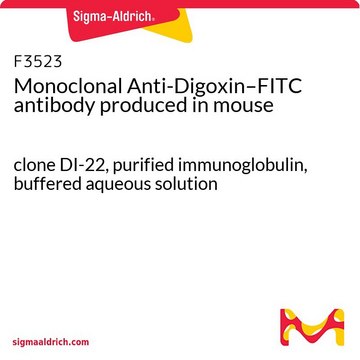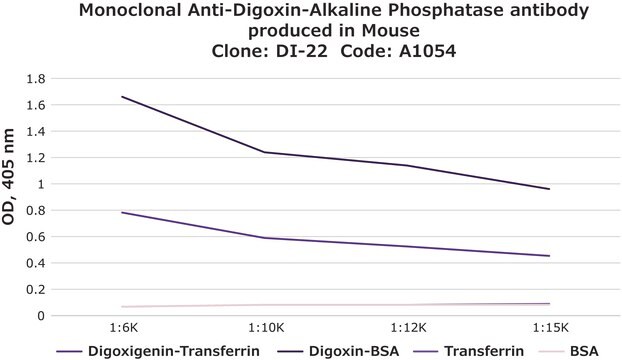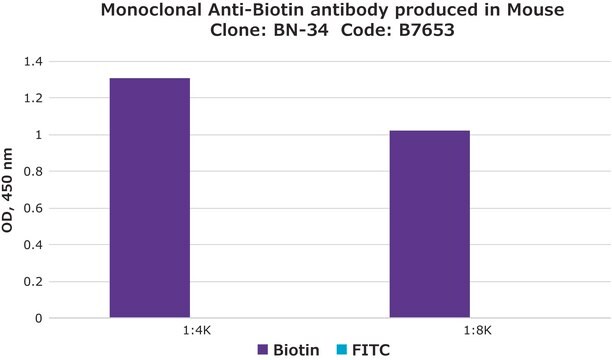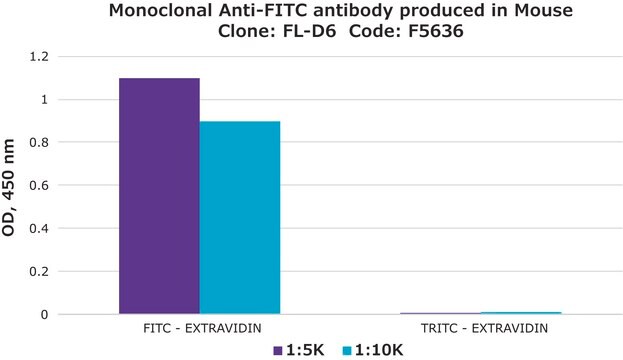11333062910
Roche
Anti-Digoxigenin
from mouse IgG1κ (clone 1.71.256)
Synonyme(s) :
anti-digoxigenin, digoxigenin
About This Item
Source biologique
mouse
Niveau de qualité
Conjugué
unconjugated
Forme d'anticorps
purified immunoglobulin
Type de produit anticorps
primary antibodies
Clone
clone 1.71.256, monoclonal
Forme
lyophilized
Conditionnement
pkg of 100 μg
Fabricant/nom de marque
Roche
Technique(s)
ELISA: 2-4 μg/mL
immunocytochemistry: 0.5-2 μg/mL
immunohistochemistry: 0.5-2 μg/mL
western blot: 0.5-2 μg/mL
Isotype
IgG1κ
Température de stockage
2-8°C
Catégories apparentées
Description générale
Spécificité
Application
- ELISA
- Immunohistocytochemistry
- In situ hybridization
- Western blot
- Immunofluorescence staining
- FISH (fluorescent in situ hybridization)
Actions biochimiques/physiologiques
Caractéristiques et avantages
- Specific to free and bound digoxigenin
- The antibody is not stabilized with protein and therefore suitable as coating antibody in Sandwich-ELISAs and for labeling procedures. For example it can be conjugated with enzymes or fluorescence dyes for direct detection of digoxigenin-labeled samples.
Notes préparatoires
- ELISA: for coating: 2 to 4 μg/ml
- Immunohistocytochemistry: 0.5 to 2 μg/ml
- In situ hybridization: 0.2 to 0.4 μg/ml
- Western blot: 0.5 to 2 μg/ml
Working solution: For coating applications
phosphate buffered saline, pH 7.4
Reconstitution
Stockage et stabilité
Remarque sur l'analyse
Autres remarques
Not finding the right product?
Try our Outil de sélection de produits.
Mention d'avertissement
Warning
Mentions de danger
Conseils de prudence
Classification des risques
Skin Sens. 1
Code de la classe de stockage
11 - Combustible Solids
Classe de danger pour l'eau (WGK)
WGK 1
Point d'éclair (°F)
does not flash
Point d'éclair (°C)
does not flash
Certificats d'analyse (COA)
Recherchez un Certificats d'analyse (COA) en saisissant le numéro de lot du produit. Les numéros de lot figurent sur l'étiquette du produit après les mots "Lot" ou "Batch".
Déjà en possession de ce produit ?
Retrouvez la documentation relative aux produits que vous avez récemment achetés dans la Bibliothèque de documents.
Les clients ont également consulté
Articles
Digoxigenin (DIG) labeling methods and kits for DNA and RNA DIG probes, random primed DNA labeling, nick translation labeling, 5’ and 3’ oligonucleotide end-labeling.
Notre équipe de scientifiques dispose d'une expérience dans tous les secteurs de la recherche, notamment en sciences de la vie, science des matériaux, synthèse chimique, chromatographie, analyse et dans de nombreux autres domaines..
Contacter notre Service technique






